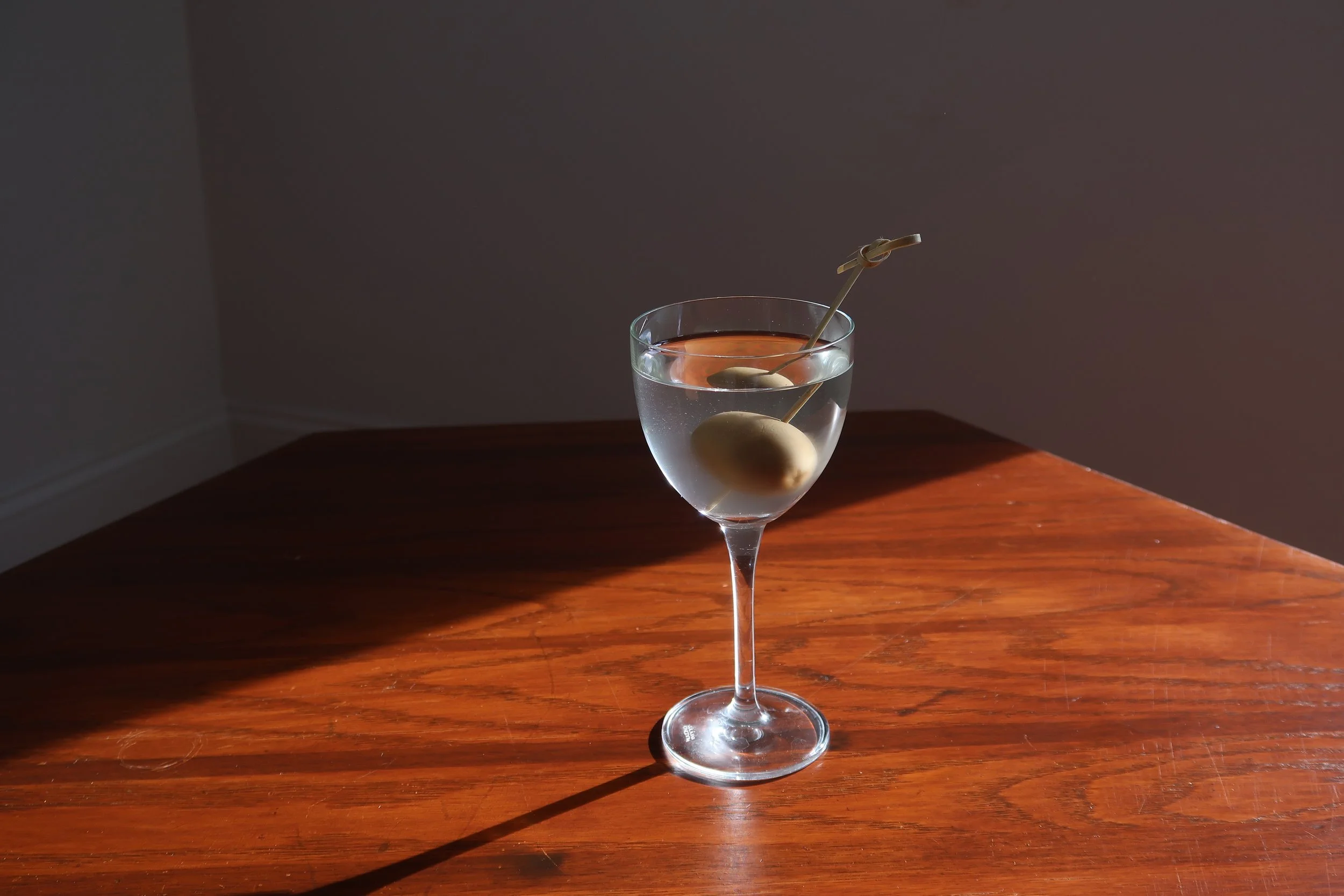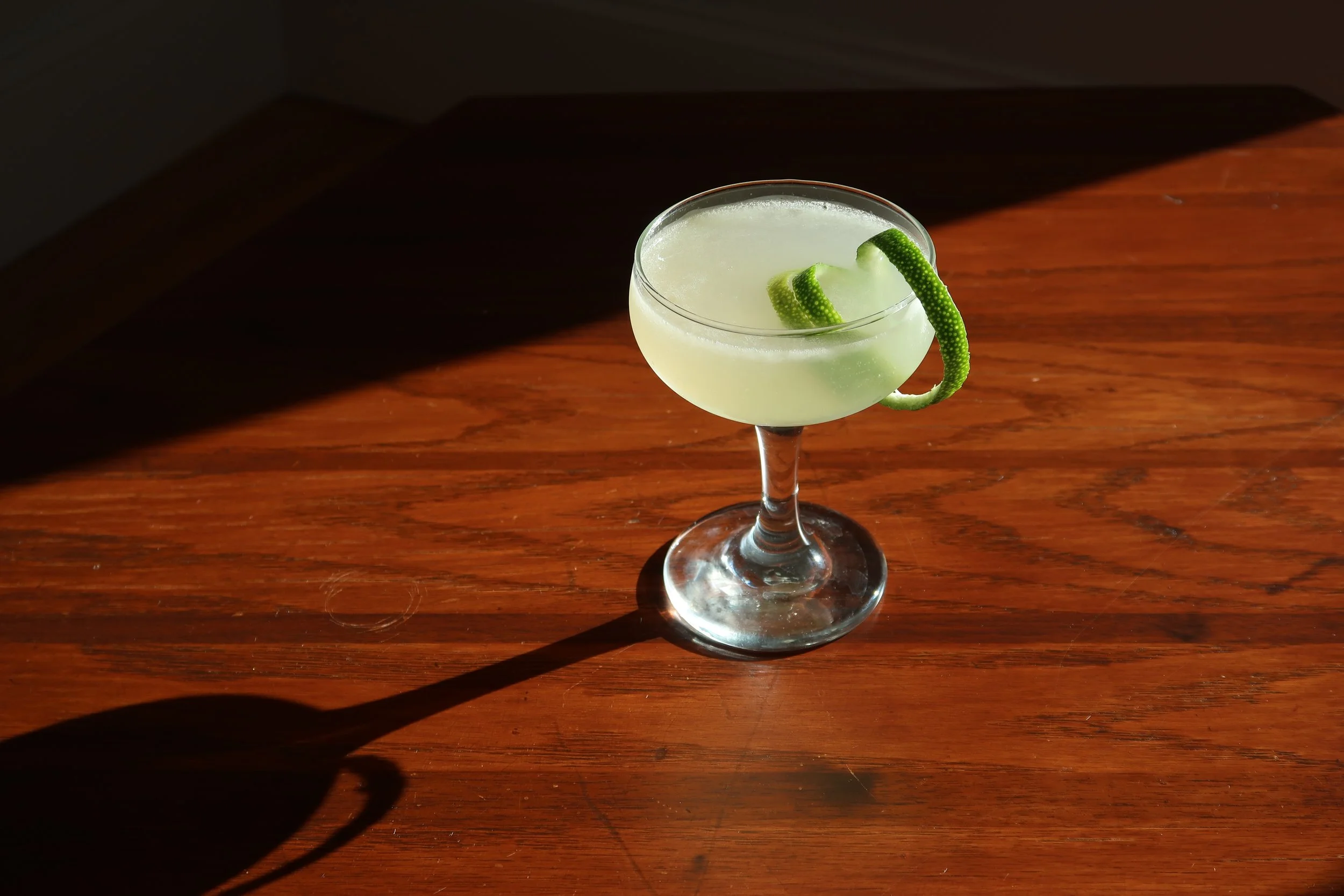St. Timothy’s Sherbet Punch
I got this idea in my head watching The Bishop's Wife (1947), the story of an angel played by Cary Grant who's trying to save a self-imporant young bishop from losing sight of what's important. In the movie, there's rag-tag children's choir at the little inner-city parish of St. Timothy's (the bishop's former post); given that sherbet punch is thoroughly postwar, I thought the kids in the choir would appreciate this one, and so might the kids in your world! I also made it balanced to please those adults who aren't partaking.
Midcentury Tom Collins
The Tom Collins had yet another life after World War II. That’s like four lives now! The postwar suburbanization of the United States, combined with the lasting effects of Prohibition, severely narrowed the once-massive canon of American drinks–but the Collins remained. In this period, it solidified into the classic form we know today; meanwhile, the John Collins ditched genever in favor of American whiskey. I added the Angostura bitters based on a 1949 recipe from the Esquire Handbook for Hosts.
Chocolate Martini
The Chocolate Martini is an interesting member of our motley ‘tini crew this month, as it claims roots in the postwar era. The possibly apocryphal story is that Rock Hudson and Elizabeth Taylor invented it on the set of Giant (1956), which is a stunning movie that was filmed mostly in Marfa, Texas. The sweet vodka-based concoction was adopted by the ‘tini craze in the ‘80s and ‘90s and it’s still ordered in bars today by lovers of dessert drinks.
Bourbon Julep
This is probably the drink that first comes to mind when you think of juleps (unless your brain is stuck in the 19th century like me)! The bourbon-based julep is the one that has survived into the modern age, thanks in no small part to its connection with the Kentucky Derby. For this recipe, I wanted it to be exceedingly elemental. Since we’ve combined the sugar and mint in our mint syrup already, this julep requires but two ingredients (plus a big bouquet of mint, of course). It is simplicity at its finest!
Midcentury Sour
The Whiskey Sour was one of the vestiges of nineteenth-century mixology to survive Prohibition and experience broad popularity during the postwar period. This is my take on what a really good bourbon-based sour reflective of that period should be with the iconic orange-and-cherry garnish. If you make it with vanilla syrup, it’s got a really nice, subtle creamsicle flavor; egg white advised.
Melon Delight
For this month’s theme, I took a look at the food menus at Borscht Belt resorts–drink menus are generally more ephemeral or nonexistent and hard to find–and even though the words “melon delight” didn’t appear, I thought they’d fit right in. This drink’s kind of an oddball as far as its construction, but it works and is exceedingly refreshing.
Midge Maisel’s Martini
Say what you will about The Marvelous Mrs. Maisel, but the episodes that take place in the Catskills are a feast for the eyes and a window into what these Borscht Belt resorts looked like. Though, as you know, I like my martinis with gin and a ratio of 2:1, I wanted to create a dry martini with a strong herbal quality… and a vodka base. The dill infusion works really well here.
Borscht Belt Bloody
After over two and half years of Al’s Cocktail Club, we’re finally making a Bloody Mary! As a veteran of New York brunch services, I am no stranger to this drink and know how beloved they are. I didn’t want to overcomplicate things and I kind of like the idea that one could build this bloody à la minute at their table with a can of tomato juice and condiments. I used the old Fort Defiance bloody mix recipe as my guide.
Staff Party Sour
One of my favorite scenes in Dirty Dancing is when Baby goes to the party the resort staff are having; she enters awkwardly carrying a watermelon and leaves suddenly kind of able to dance?! This simple vodka sour drinks like a Daiquiri, which is exactly what I want when I’ve worked up a sweat dancing to “Cry to Me” by Solomon Burke.
Hawaiian Mai Tai
The Mai Tai didn’t originate in Hawaii, but in the archipelago’s postwar tourism boom, the drink was quickly adopted into its hotel and bar culture. The drink developed into a fruitier, less strictly-defined subgenre unto itself, with orange and pineapple popping up frequently. Our version opts for passionfruit (which I love), layered over my own Banana Mai Tai recipe.
Surf Rider Sling
I noticed this description under a Hawaiian Room drink called the Okoolehao Sling–“A zingy sling of gin and juice in a real coconut”–and took it as a prompt. I wanted to create a fruity coconutty flash-blended drink with a gin base and I couldn’t be happier with the results! Though it does appear in tiki drinks, I see coconut as belonging more to the non-tiki tropical canon we’re (mostly) focusing on this month.
Halekulani Old-Fashioned
The Halekulani–a whiskey-based sour with lemon, orange, pineapple, demerara sugar, grenadine, and bitters–has always intrigued me. Another non-rum tropical drink from Hawaiian hotel history, this one originated at the House Without a Key Lounge at Waikiki’s Halekulani Hotel. I decided to turn this into a stirred, spirit-forward drink–the result is a tropical Improved Cocktail with a nod to all of the original elements, plus our banana mix and a touch of absinthe.
Royal Hawaiian
This drink originated at the Royal Hawaiian Hotel in Honolulu and is a prime example of the non-tiki tropical canon. I wanted to improve the recipe while also playing up the pre-WWII orgeat sours that came before it, like the Cameron’s Kick and the Army & Navy. I did so with bitters and an absinthe rinse–the latter touch is reminiscent of the Corpse Reviver No. 2 and the Rattlesnake.
Midcentury Margarita
The classic spec for a Margarita started firming up in the late 1930s, though not necessarily going by its now-famous name yet. The drink took hold of America in the 1950s on a grand scale and this classic version with orange liqueur served up reflects the drink’s aesthetic at the time. The sugar-salt rim sprang from my fascination with people who order sugar rims on their Margaritas, but trust me on this one–it works!
The Old-Fashioned
When, in the post-Civil War era, Fancy & Improved Cocktails came on the scene followed by the Vermouth Cocktail and Manhattan, people needed a way to order the more elemental Cocktail and the term “Old-Fashioned” was applied to the simple spirits-sugar-water-bitters formula. This version is an attempt to capture what happened to the Cocktail during the twentieth century–we stop short of muddling fruit but cherry syrup and stirring with an expressed orange peel give it a subtly similar effect. Rye and bourbon are both popular bases for this iteration of the drink.
Roasted Strawberry Daiquiri
This frozen Daiquiri riff brings us into the later twentieth century, when most people began to experience the Daiquiri in blended form and, often, with more in the way of artificial flavorings. Chain restaurants latched onto the Strawberry Daiquiri, as did tourist destinations in hot climates, like New Orleans or Key West. That said, the combination of rum, lime, sugar, and strawberries is exceedingly pleasing, especially when the strawberries have been roasted to concentrate their sweetness.
County Clare Coffee
Nothing could ever top the Fort Defiance Irish Coffee; built like a boozy Americano and sweetened with a basic simple syrup, it’s the pinnacle of the form. However, I was intrigued by the idea of adding some tropical flair to this classic, and I like what the lime and banana achieve here. I named this version after the county where the Shannon Airport is located, an important place in the history of Irish Coffee.
Dinner Jacket
This one takes inspiration from several members of the Martini family tree, including the Vesper, the Marguerite and the Tuxedo No. 2. That last one inspired the name—British import known as the dinner jacket was nicknamed after the Tuxedo Club in Westchester and has been known as such ever since.
The Old Prince
This Stinger riff more closely resembles the Prince and Brant cocktails, both of which call for bitters to be added to the Stinger’s simple combination of Cognac and crème de menthe. Ours switches out the French brandy in favor of bourbon and adds gentian liqueur and a little salinity, all served over crushed ice, a popular presentation during the postwar period.
Southside Cinnamint
The Southside cocktail very likely originated on Long Island in the waning years of the nineteenth century. Simply a Gimlet (or St. Peter) with mint, our version features the unexpected-but-welcome addition of cinnamon to this classic sour.




















